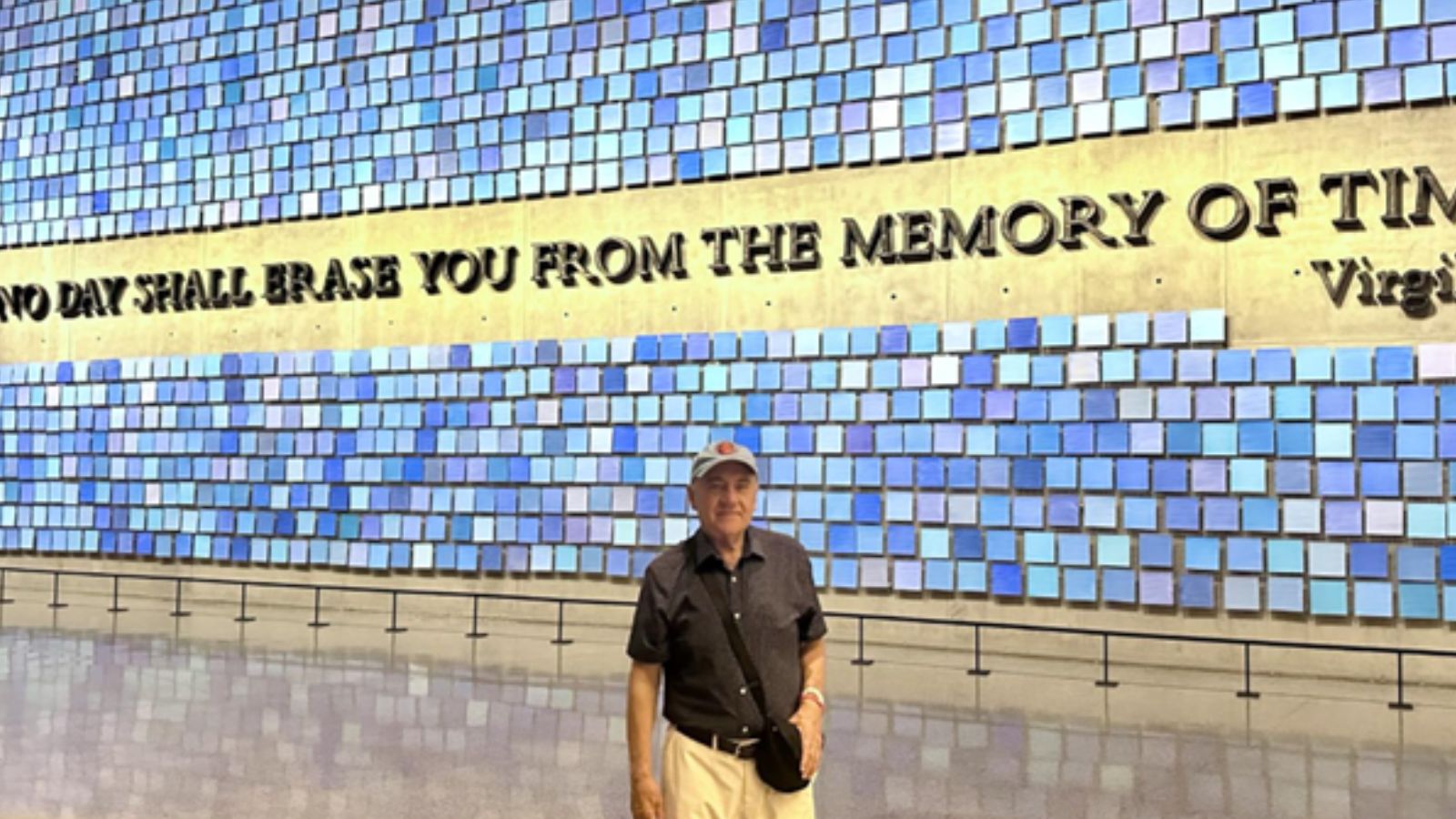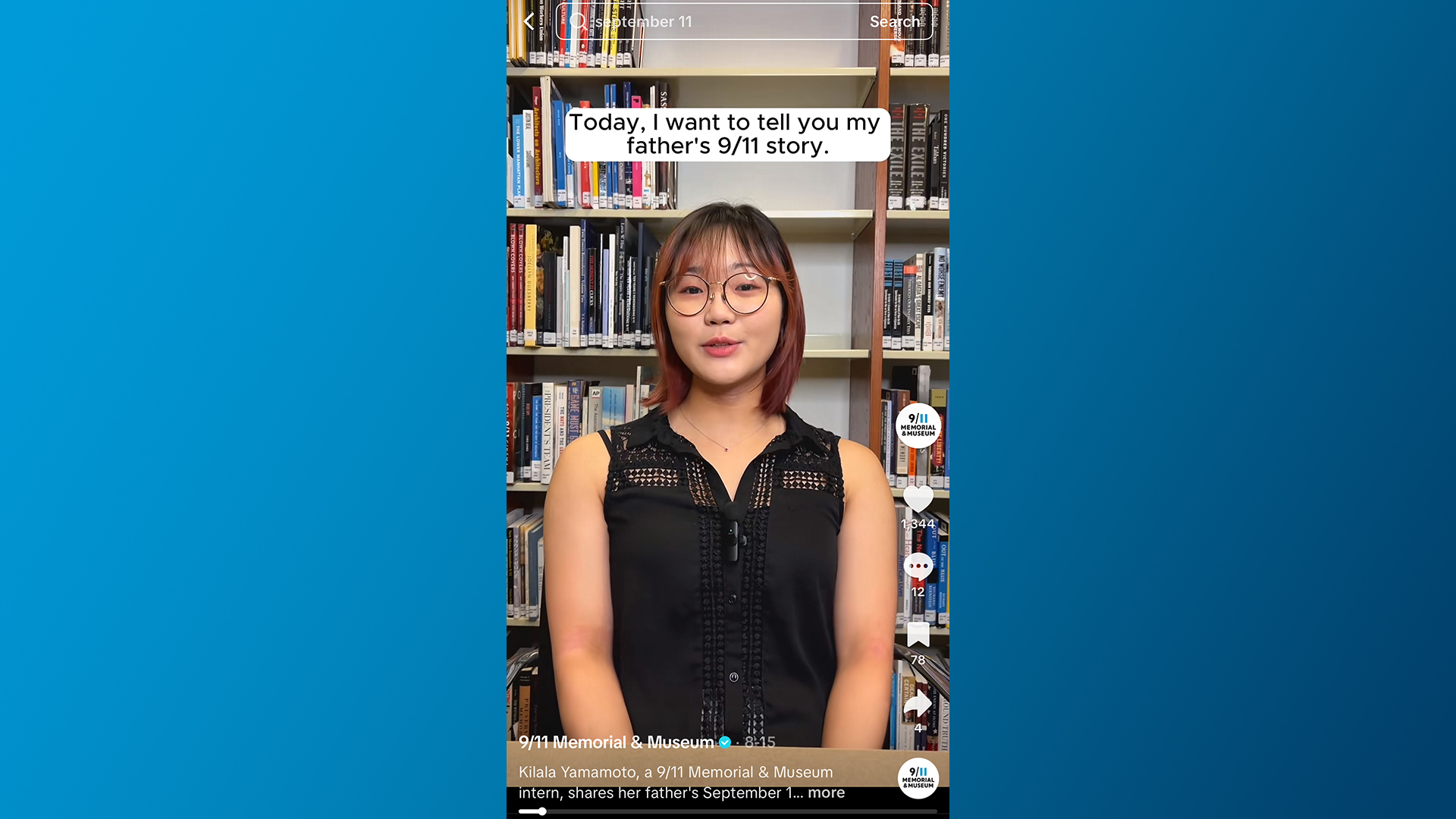Make a donation to the museum
Intern Elizabeth Morris Interviews a Role Model About His 9/11 Experience
Intern Elizabeth Morris Interviews a Role Model About His 9/11 Experience
- October 21, 2025
This summer I interned at the 9/11 Memorial & Museum in the Government and Community Affairs Department. As part of the internship, I engaged with the members of the 9/11 community, and doing so reminded me of someone in my life who was impacted by 9/11. Frederick Agnostakis was the Athletic Director at my high school, Loyola School, on the Upper East Side of Manhattan. During my internship, "Coach A" and I visited the Museum together. He openly shared his recollections of September 11, 2001, with me. I am proud to have made this connection between generations and have the opportunity to share Fred’s story below, in his own words.

September 11, 2001, was the second day of the school year. I remember it clearly, not because of what came later, but because of how the day began. The sky was impossibly blue. Not a cloud in sight. I left my apartment near the Museum of Natural History and walked to Loyola School through Central Park. It was a routine. I did it every Monday through Friday, nearly every day for 12 years. It was comfortable for me. The early light filtered through the trees, and for a moment, everything in the world felt crisp and clean and full of promise. Little did I know how much that day would soon propel me from my creature comforts, from normality, from my lovely routine.
I was the Athletic Director at Loyola School then. A coach, a teacher, someone whose days were filled with whistles and whiteboards, practices, and papers. I was in the gymnasium running orientation when our Dean of Students quietly handed me a slip of paper.
“Two small planes have collided with the Twin Towers.”
I remember reading those words and not understanding. I remember looking at the students, some of them still in their summer tans, just returning to school. They watched me with curious eyes, waiting for a directive.
“Whose parents work downtown?” I roared with my regular sports coach aggression.
A flurry of hands shot up.
“Go to the front office. Move with a purpose.” I tried to keep my voice steady as they filtered out.
Back in my office, our art teacher and volleyball coach came in and asked if he could stay at my place that night. He lived in Gateway Plaza, across from the Towers. His voice was calm, but his eyes weren’t. We had to leave the bubble we had created for ourselves in the charming school on the Upper East Side. Before then, I didn’t want to know. We decidedly turned on the TV together. We watched in silence. Neither of us could speak. The silence between us was heavier than anything I’d ever felt.
The world had cracked open.
That night, we didn’t — we couldn’t — sleep. The next morning, we walked down to Chelsea Piers, trying to get him back to his apartment. But Chelsea Piers had become something else. It was a staging ground for rescue crews, emergency workers, and volunteers. Suddenly, I wasn’t a coach anymore. I was just a man who wanted to help.
An organizer asked me my boot size. They handed me a shovel, taped a number — 237 — to my shirt, and told me to write my Social Security number on my arms and legs. That moment, when you write your own number on your skin in case you don’t come back, it doesn’t leave you.
I boarded a city bus full of volunteers and rode toward the wreckage. We could see the South Tower’s remains rising like a skeletal fist through the dust. We were only there for ten minutes before the NYPD pulled us out. I didn’t want to go. I begged to stay. The sheriff gave me a reflective vest and asked if I could drive a van of bottled water to the firemen. I nodded. That was the beginning of my new routine. My new normality.
For days, I drove back and forth from Pier 40, loading and unloading cases of water. Later, I helped sort supplies — boots, gloves, clothing — onto gold carts headed for Ground Zero. We moved like ants under a sunless sky. No one asked for thanks. No one had time for it.
I remember sitting on a box one afternoon, scribbling a poem called “Crosses.” Around me, iron workers rested with their heads bowed. MTA workers with soot on their hands shared cigarettes. Fighter jets circled overhead.
A volunteer next to me, a man from Serbia, glanced up and said, “At least they’re not bombing us.”
He said it like a man who’d lived through the sound.
The dust settled on everything. On our boots, on our lungs, on our spirits. But we kept going. New Yorkers never quit.
And that’s what I want you to understand.
I’ve coached state champions. I’ve led locker rooms where boys became men and where young women learned to hold their ground. I’ve taught in classrooms where the most important lesson wasn’t on the syllabus. But nothing — not a single medal or banner —taught me more than those days after 9/11. It taught me what service looks like. What sacrifice really costs. What unity feels like when it’s stripped of politics and pride.
And that is why it must be taught.
We cannot let this generation forget. Not just the images, not just the facts, but the feeling. The stunned silence. The sirens. The incredible courage. The heartbreak. The names that were never again called during roll.
Our students deserve to know what came before them — not to feel fear, but to understand strength. The kind of strength that shows up in a reflective vest and drives a van of water into the smoke. The kind that stands beside strangers and calls them brothers.
So I share this not just as a coach or a teacher, but as a witness. As someone who walked into the school gym that morning under a blue sky and walked out into history. Please don’t let it disappear from our classrooms. Teach it. Never Forget.
By Elizabeth Morris, 9/11 Memorial & Museum Intern
Previous Post
Intern Kilala Yamamoto Shares her Father's Story on TikTok

Kilala Yamamoto, a summer intern, created a TikTok video to share her father's ties to the World Trade Center and her subsequent connection to the events of 9/11.
Next Post
WTC Health Program Introduces Young Adult Outreach Videos

From asthma to cancer, many who were children or students on 9/11 and spent time near Ground Zero are now young adults suffering from potentially related diseases. New outreach videos from the WTC Health Program are helping to raise awareness.